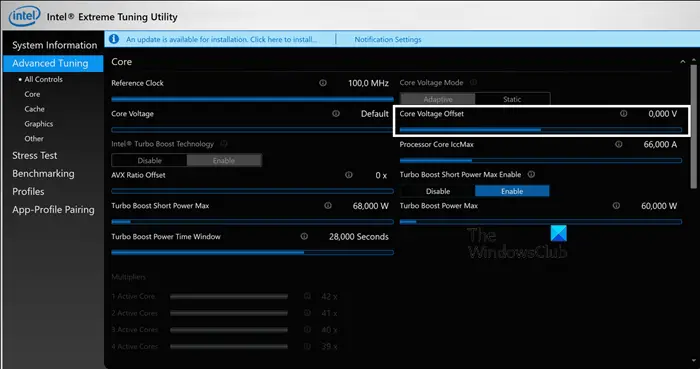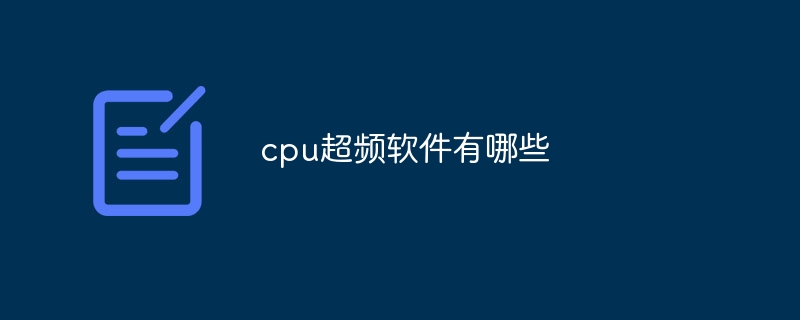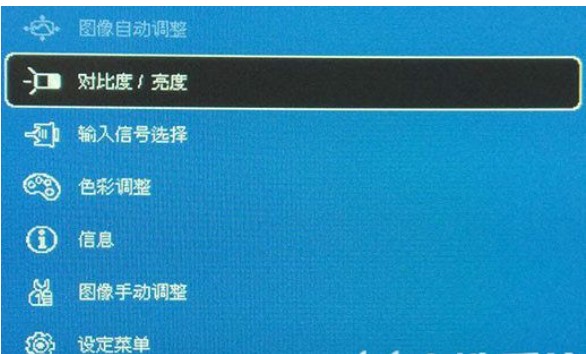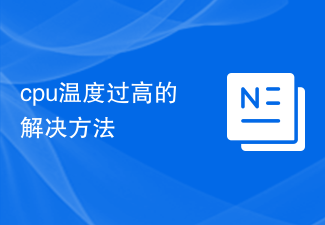Display overclocking means that the resolution or refresh rate set by the host system exceeds the maximum range that the current monitor can display. Solution: 1. Restart the computer and enter safe mode; 2. Right-click on the desktop, select "Screen Resolution", and click "Advanced Settings"; 3. Select one from the displayed list of valid modes and click "OK" - Just "Apply".

The operating environment of this tutorial: Windows 7 system, Dell G3 computer.
Display overclocking means that the resolution or refresh rate set by the host system exceeds the maximum range that the current monitor can display.
Solution:
1. Press the computer power button and then press F8 continuously.

#2. From the previous step, you can enter the interface shown below. Use the "↑" and "↓" keys on the keyboard to select "Safe Mode".

#3. Click the Enter key on the keyboard and wait to enter the system.
4. Right-click on the desktop and select "Screen Resolution".

#5. Click "Advanced Settings" on the right side of the pop-up dialog page.

#6. Click "List all modes" at the bottom of the newly popped-up dialog box.

7. Select one from the displayed list of valid modes and click OK.
#8. Click "Apply" in the display adapter type dialog box to complete the resolution modification.
To read more related articles, please visit PHP Chinese website! !
The above is the detailed content of What does display overclocking mean?. For more information, please follow other related articles on the PHP Chinese website!
 如何使用Intel XTU对CPU进行欠压和超频Feb 19, 2024 am 11:06 AM
如何使用Intel XTU对CPU进行欠压和超频Feb 19, 2024 am 11:06 AM英特尔XTU是一款强大的应用程序,可让您轻松管理计算机的性能。您可以通过调整CPU电压来解决过热问题,或者通过超频来提升性能。在这篇文章中,我们将探讨如何利用英特尔XTU来优化计算机的性能,无论是调整电压还是进行超频。欠压和超频对CPU有什么作用?在我们继续学习如何对CPU进行欠压和超频之前,首先必须了解它们是什么。欠电压指的是逐渐降低CPU所需的电压。这一过程有助于减少热量排放,因为高电压会导致更高的温度。通过减少CPU的电压供应,可以有效地降低温度。如果笔记本在发热后开始减速,应及时解决问题
 如何增加电脑CPU的时钟频率Feb 20, 2024 am 09:54 AM
如何增加电脑CPU的时钟频率Feb 20, 2024 am 09:54 AM电脑CPU如何超频随着科技的不断进步,人们对于电脑性能的需求也越来越高。而一种有效的提升电脑性能的方法就是通过超频(overclocking)来增加CPU的工作频率。超频可以使CPU更快地处理数据,从而提供更高的计算能力。那么,电脑CPU如何超频呢?下面将为大家介绍超频的基本原理和具体操作方法。首先,让我们了解一下超频的原理。CPU的工作频率是由主板上的晶振
 苹果 曝 iPhone16 或实现更大显示屏Mar 22, 2024 pm 06:41 PM
苹果 曝 iPhone16 或实现更大显示屏Mar 22, 2024 pm 06:41 PM虽然距离iPhone16系列发布还要许久,但外观和配置相关爆料就没断过。据韩国媒体SisaJournal报道,苹果计划在即将推出的iPhone16系列手机中引入全新的超窄边框技术。该技术涉及将内部铜线卷成更紧凑的结构,以缩小手机底部显示屏的边框宽度,从而实现更大尺寸的显示屏。这一创新举措旨在提升用户体验,让用户享受更广阔的视野和更沉浸式的娱乐体验。苹果一直致力于不断改进其产品设计和技术,为用户带来更先进的功能和性能。iPhone16系列手机的推出将进一步巩固苹果在智能另据@刹那数码爆料,苹果新一
 cpu超频软件有哪些Aug 15, 2023 am 10:36 AM
cpu超频软件有哪些Aug 15, 2023 am 10:36 AMcpu超频软件有:1、Intel Extreme Tuning Utility,适用于英特尔处理器;2、AMD Ryzen Master,专为AMD Ryzen处理器设计;3、MSI Afterburner,主要用于显卡超频,但也可以用于调整CPU频率和电压;4、ASUS AI Suite,用于调整华硕主板上的CPU参数和电压,实现超频和性能优化。
 显示器超频是什么意思Feb 23, 2023 pm 03:53 PM
显示器超频是什么意思Feb 23, 2023 pm 03:53 PM显示器超频就是指屏幕刷新频率超过了当前显示器能显示的最大范围。超频是一种通过调整硬件设置提高芯片的主频来获得超过额定频率性能的技术手段。显示器超频的原因有:1、自己手动设置频率导致超频;2、显示器配置低造成的;3、驱动不兼容造成的。
 解决方案win7显示屏模糊有重影Jul 14, 2023 pm 09:41 PM
解决方案win7显示屏模糊有重影Jul 14, 2023 pm 09:41 PM一些Win7客户遇到了显示器模糊和重影的情况,导致视觉体验很差。在这种情况下我们该怎么办?您可以先打开显示器的设置控制面板,看看上面的内容是否有重影。如果有问题,请立即修复显示器;如果没有,您可以检查显示器的电极连接线,看看是否插入或插头变形。必须以不同的方式处理不同的情况。解决方案win7显示屏模糊有重影。1.首先将其调整到显示器的设置菜单页面,以查询显示器设置菜单上的文本是否有拖拽阴影。如果是,则证明显示器是常见故障,并立即修复显示器。如果显示器的设置菜单显示没有重影,显示器本身应该没有问题
 三星将为微软 MR 头显提供显示屏 设备有望更轻便显示更清晰Aug 10, 2024 pm 09:45 PM
三星将为微软 MR 头显提供显示屏 设备有望更轻便显示更清晰Aug 10, 2024 pm 09:45 PM近日,三星显示(SamsungDisplay)与微软公司签署了一项重要合作协议。根据协议,三星显示将为微软开发和供应数十万台适用于混合现实(MR)头显设备的OLEDoS面板,而微软正开发一款面向游戏和电影等多媒体内容的MR设备,这款设备预计将在OLEDoS规格确定后推出,主要服务于商用领域,预计最早于2026年交付。OLEDoS(OLEDonSilicon)技术OLEDoS是一种新型显示屏技术,将OLED沉积在硅基板上,相较于传统的玻璃基板,具有更薄、像素更高的特点。OLEDoS显示屏与普通显示
 cpu温度过高的解决方法Feb 21, 2024 pm 05:45 PM
cpu温度过高的解决方法Feb 21, 2024 pm 05:45 PMCPU温度过高的解决方法随着电脑的普及和使用频率的增加,人们对于CPU温度过高的问题也越来越关注。过高的CPU温度不仅会降低电脑的性能,还会缩短电脑的寿命。因此,如何有效降低CPU的温度成为了很多电脑用户关心的话题。本文将从硬件和软件两个方面介绍一些常见的CPU温度过高的解决方法。一、硬件方面的解决方法清洁风扇和散热器风扇和散热器是冷却CPU的重要组件,如果

Hot AI Tools

Undresser.AI Undress
AI-powered app for creating realistic nude photos

AI Clothes Remover
Online AI tool for removing clothes from photos.

Undress AI Tool
Undress images for free

Clothoff.io
AI clothes remover

AI Hentai Generator
Generate AI Hentai for free.

Hot Article

Hot Tools

Dreamweaver Mac version
Visual web development tools

Atom editor mac version download
The most popular open source editor

WebStorm Mac version
Useful JavaScript development tools

VSCode Windows 64-bit Download
A free and powerful IDE editor launched by Microsoft

Notepad++7.3.1
Easy-to-use and free code editor








